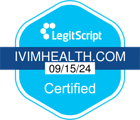Bioidentical vs. Synthetic Hormones: A Closer Look at the Differences
Why Hormone Optimization Matters
As more women seek proactive and personalized ways to support their health during midlife and beyond, conversations around hormone optimization are becoming increasingly important. Women are finding themselves questioning traditional, one-size-fits-all approaches and exploring options that reflect their evolving individual needs and goals.
Ivim Health’s Women’s Hormone Optimization Program is designed with this in mind—offering a tailored, evidence-based approach to hormone treatment that prioritizes safety, personalization, and long-term well-being. Understanding the difference between bioidentical and synthetic hormones is a foundational part of making confident, informed decisions on your health journey.
Understanding Bioidentical Hormones and Hormone Optimization
Bioidentical hormones are made in a lab to be just like the hormones your body makes naturally. These hormones are typically sourced from plants like soy or yams, then carefully refined to have the same chemical structure as the body’s natural hormones.
In the context of hormone optimization, these bioidentical hormones are used to support hormonal balance during life stages such as perimenopause and menopause, when natural hormone production may shift or decline. Bioidentical hormones may help support key areas such as:
- Mood stability
- Mental clarity and focus
- Restful sleep
- Energy levels
- Overall sense of vitality
Because bioidentical hormones can be customized in both formulation and dose, they may offer more flexibility needed for a more individualized approach to hormone optimization.
With Ivim’s individualized treatment approach, your provider will discuss your safest treatment options, and together you will form your personalized treatment plan.
Synthetic Hormones in Traditional Care
Synthetic hormones aren’t exact copies of the body’s natural hormones, but they’re designed to act in a similar way. While these hormones can be effective and have been used for decades in traditional hormone therapies, their molecular structures often differ slightly from the hormones produced by your body.
Because their structures differ slightly, synthetic hormones may be processed differently in the body and may bind to hormone receptors in unique ways. While synthetic options may work well for some women, others may seek bioidentical alternatives due to concerns about tolerability, side effects, or lack of personalization in standard dosing.
The decision to use bioidentical or synthetic hormones is highly individualized and should be made with the guidance of a qualified medical provider who understands your health history and goals.
Common Synthetic Hormones Used in Traditional Care:
- Ethinyl Estradiol: A synthetic form of estrogen often found in birth control pills.
- Conjugated Estrogens (e.g., Premarin®): Sourced from the urine of pregnant mares, this blend contains several types of estrogen, including some that do not naturally occur in the human body.
- Medroxyprogesterone Acetate (Provera®): A synthetic progestin used in combination hormone therapy or to regulate menstrual cycles.
- Norethindrone Acetate: A synthetic progestin often used in oral contraceptives and hormone therapy.
- Levonorgestrel: Another synthetic progestin found in many birth control options and hormonal IUDs.
Understanding these options helps women make informed choices about their hormone health and find the best fit for their individual needs.
Personalized Approaches to Bioidentical Hormones
For many women exploring hormone optimization, bioidentical hormones are part of a broader shift toward more individualized care. Rather than following one-size-fits-all protocols, today’s approaches often emphasize customization based on factors like lab results, symptom patterns, and evolving lifestyle needs.
Flexible dosing, ongoing monitoring, and regular communication with healthcare providers can help ensure that hormone support remains therapeutic and aligned with a woman’s changing goals. This personalized model may offer a greater sense of clarity, empowerment, and support during midlife transitions.
Hormones in Focus: Estradiol and Progesterone
Two of the most commonly used hormones in optimization plans are:
Estradiol
Estradiol is a type of estrogen that helps keep bones strong, minimizes hot flashes, and improves vaginal symptoms associated with menopause. It is often used to support women during and after the menopausal transition.
Progesterone
This hormone supports cycle regularity and may improve sleep and emotional well-being. When used alongside estrogen, progesterone helps maintain hormone balance and protects the uterine lining when combined with estrogen.
Your Ivim provider will help determine the best combination and delivery method based on your preferences and clinical profile.
Medication Options in Ivim’s Hormone Optimization Program
Ivim Health offers multiple bioidentical hormone formulations, all designed for ease of use and therapeutic effectiveness. These options can be prescribed alone or in combination, depending on individual needs.
Estradiol Patch
The transdermal estradiol patch delivers hormones consistently and may lead to fewer fluctuations compared to oral options. Research shows it is also associated with a lower risk of blood clots than some oral formulations, making it a commonly recommended option in most cases.
Progesterone Oral Capsule
This bioidentical option helps regulate menstrual cycles and plays a protective role by preventing thickening of the uterine lining when estrogen is used. It also may support sleep and mood regulation.
Estradiol + Progesterone Oral Capsule
A convenient once-daily capsule combining both hormones. Ideal for women who cannot use a patch or who prefer a daily oral routine. This formulation supports a simple and consistent approach to hormone optimization.
Each option is reviewed and discussed in consultation with your Ivim Health provider. The goal is to match treatment with your symptoms, preferences, and lifestyle, while supporting long-term hormonal balance.
Safety and Monitoring in Hormone Optimization
Any form of hormone support, whether bioidentical or synthetic, requires a thoughtful and evidence-informed approach. At Ivim Health, safety and monitoring are core pillars of the Women’s Hormone Optimization Program.
Ivim’s Hormone Optimization Membership includes:
- Regular lab testing to monitor hormone levels
- Virtual follow-ups with licensed clinicians
- Adjustments based on your symptoms and data over time
This approach helps ensure your plan is both effective and aligned with your personal health goals.
The Value of Personalized Hormone Optimization
One of the strongest benefits of Ivim’s model is its commitment to personalized care. Each woman’s hormonal health is unique, and a treatment that benefits one person might not be effective for someone else.
In Ivim’s Women’s Hormone Optimization Program, treatment is not only about relieving symptoms, but also about helping you feel grounded and supported as you navigate hormonal shifts. Your plan may evolve over time, and that’s expected. Through continuous communication and regular reassessment, your care team ensures your hormone support remains relevant, safe, and effective.
This personalized method is designed to nurture the woman as a whole, rather than simply addressing isolated symptoms.
Is Hormone Optimization Right for You?
Many women begin to consider hormone optimization when they experience symptoms such as:
- Fatigue
- Mood fluctuations
- Brain fog
- Low libido
- Night sweats or disrupted sleep
These symptoms may be related to hormonal shifts or imbalances—often beginning in the 40s and continuing through the 50s and beyond. Addressing these changes early may help support daily wellbeing and preserve long-term vitality.
If you’re unsure whether hormone optimization is right for you, a virtual consultation with an Ivim Health provider can provide clarity and direction, as well as assess your history and labs to build a plan tailored to you.
Getting Started with Ivim Health
Getting started with hormone optimization at Ivim Health is straightforward and supportive. The process is designed to ensure your care is personalized, informed, and easy to manage through virtual check-ins, convenient deliveries, and ongoing guidance.
- Step 1: Complete Questionnaire
Create an account and fill out a secure form covering health history, symptoms, and goals.
- Step 2: Telehealth Visit
Meet your provider through a virtual appointment to review your health, preferences, and program details.
- Step 3: Enroll & Pay
Receive a link to enroll, pay for your program, which includes medication and labs, and select optional add-ons (additional fee may apply). Due to medication and lab costs a 4-month commitment is required. - Step 4: Receive Meds & Labs
Medications ship in 2-month increments. Lab kits can be sent if requested to monitor baseline levels (recommended, not required). - Step 5: Check-ins & Refills
Video consults are required before refills to review progress, discuss updates, and adjust your plan as needed.
Final Thoughts
Hormone optimization is about more than fixing symptoms—it’s about reclaiming balance and vitality in a way that supports your body and your goals. Whether you’re navigating perimenopause or feeling off balance in your 50s or 60s, the Women’s Hormone Optimization Program at Ivim Health offers a supportive, flexible, and thoughtful approach to feeling your best.
If you’re ready to explore how personalized hormone support may fit into your life, Ivim is here to help you get started.
Reviewed by Dr. Emily Bigby, MD provider with Ivím Health
Disclaimer:
This content is for informational purposes only and is not a substitute for professional medical advice. Always consult a qualified healthcare provider before making decisions about hormone therapy or related treatments.
Sources:
- Cleveland Clinic. “Bioidentical Hormones.” Cleveland Clinic, 13 Sept. 2023, https://my.clevelandclinic.org/health/treatments/15660-bioidentical-hormones.
- Synthetic Hormones. ScienceDirect, https://www.sciencedirect.com/topics/agricultural-and-biological-sciences/synthetic-hormones.
- ScienceDirect – Ethinyl Estradiol
“Ethinyl Estradiol.” ScienceDirect, Elsevier.
https://www.sciencedirect.com/topics/biochemistry-genetics-and-molecular-biology/ethinyl-estradiol.
- Mayo Clinic – Conjugated Estrogens (Oral Route)
“Conjugated Estrogens (Oral Route).” Mayo Clinic, Mayo Foundation for Medical Education and Research, 1 April 2023.
https://www.mayoclinic.org/drugs-supplements/conjugated-estrogens-oral-route/description/drg-20075319.
- Mayo Clinic – Medroxyprogesterone (Oral Route)
“Medroxyprogesterone (Oral Route).” Mayo Clinic, Mayo Foundation for Medical Education and Research, 1 April 2023.
https://www.mayoclinic.org/drugs-supplements/medroxyprogesterone-oral-route/description/drg-20146771.
- Mayo Clinic – Levonorgestrel (Oral Route)
“Levonorgestrel (Oral Route).” Mayo Clinic, Mayo Foundation for Medical Education and Research, 1 April 2023.
https://www.mayoclinic.org/drugs-supplements/levonorgestrel-oral-route/description/drg-20074413.
- “What Is Bioidentical Hormone Replacement Therapy?” WebMD, https://www.webmd.com/menopause/what-is-bioidentical-hormone-replacement-therapy.
- Estradiol. Drugs.com, https://www.drugs.com/estradiol.html.
- “Progesterone: Uses and Risks.” WebMD, https://www.webmd.com/vitamins-and-supplements/progesterone-uses-and-risks.
- Kuhl, H. “Pharmacology of Estrogens and Progestogens: Influence of Different Routes of Administration.” Climacteric, vol. 8, suppl. 1, 2005, pp. 3–63. PubMed, https://pubmed.ncbi.nlm.nih.gov/16112947/. DOI: 10.1080/13697130500148875.
- Hormonal Imbalance.” Cleveland Clinic, https://my.clevelandclinic.org/health/diseases/22673-hormonal-imbalance.


